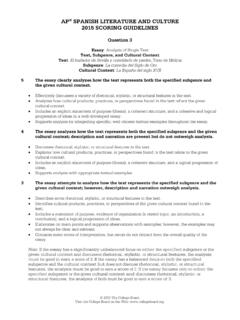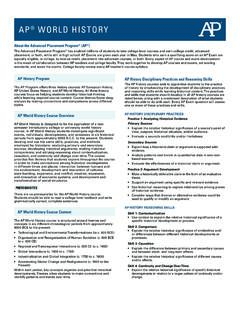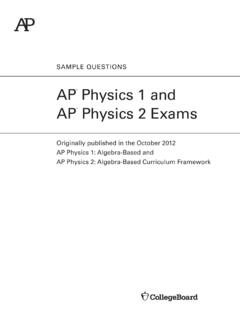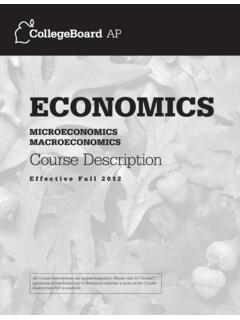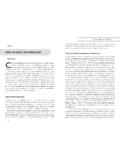Transcription of ap10 biology scoring guidelines - College Board
1 AP biology 2010 scoring guidelines The College Board The College Board is a not-for-profit membership association whose mission is to connect students to College success and opportunity. Founded in 1900, the College Board is composed of more than 5,700 schools, colleges, universities and other educational organizations. Each year, the College Board serves seven million students and their parents, 23,000 high schools, and 3,800 colleges through major programs and services in College readiness, College admission, guidance, assessment, financial aid and enrollment. Among its widely recognized programs are the SAT , the PSAT/NMSQT , the Advanced Placement Program (AP ), SpringBoard and ACCUPLACER.
2 The College Board is committed to the principles of excellence and equity, and that commitment is embodied in all of its programs, services, activities and concerns. 2010 The College Board . College Board , ACCUPLACER, Advanced Placement Program, AP, AP Central, SAT, SpringBoard and the acorn logo are registered trademarks of the College Board . Admitted Class Evaluation Service is a trademark owned by the College Board . PSAT/NMSQT is a registered trademark of the College Board and National Merit Scholarship Corporation. All other products and services may be trademarks of their respective owners. Permission to use copyrighted College Board materials may be requested online at: Visit the College Board on the Web: AP Central is the official online home for the AP Program: AP biology 2010 scoring guidelines 2010 The College Board .
3 Visit the College Board on the Web: Question 1 Homeostatic maintenance of optimal blood glucose levels has been intensively studied in vertebrate organisms. *NOTE: Points for parts (a), (b) or (c) may be found in any part of the response. (a) Pancreatic hormones regulate blood glucose levels. Identify TWO pancreatic hormones and describe the effect of each hormone on blood glucose levels. (4 points maximum) Identification of hormone 1 point each (2 points maximum) Effect of hormone on blood glucose levels 1 point each (1 point maximum per hormone) Insulin (humulin) Decreases/lowers blood glucose level. Glucagon NOTE: A hormone name beginning with gly- is not acceptable. Increases/raises blood glucose level.
4 Somatostatin Increases/raises blood glucose level. (b) For ONE of the hormones you identified in (a), identify ONE target cell and discuss the mechanism by which the hormone can alter activity in that target cell. Include in your discussion a description of reception, cellular transduction, and response. (4 points maximum) 1 point: target cell 1 point: description of reception 1 point: discussion of transduction 1 point: discussion of response of target cell Insulin Target cells: Any cell except Reception: Insulin binds to a specific receptor (tyrosine kinase) on the cell surface. red blood cells, or brain cells unless specified as neuroglial cells. o Ligand binding to two adjacent monomers forms an active dimer (tyrosine kinase).
5 O Dimer and other proteins become phosphorylated. Transduction: Binding of signaling molecule alters the receptor protein in some way. o Stimulates a cascade pathway/mediated by a second messenger/amplifies signal. Response: Transduced signal triggers a specific action by the target cell. Specify one of the following: o Increases/raises cellular uptake of glucose. o Increases formation of glycogen from glucose in liver/(skeletal) muscle cells as intracellular glucose is incorporated into glycogen (glycogenesis). o Increases rate of intracellular catabolism of glucose. o Increases fat synthesis from glucose in liver cells and adipose tissue. o Decreases gluconeogenesis, the conversion of amino acids and glycerol from fats to new molecules of glucose.
6 O Phosphorylated transcription factors can alter gene expression. o Facilitated diffusion of glucose. (Glucose is phosphorylated into glucose-6-phosphate to preserve the concentration gradient so glucose will continue to enter the cell.) o Cells with more glucose transporters increase departure of glucose from blood. AP biology 2010 scoring guidelines 2010 The College Board . Visit the College Board on the Web: Question 1 (continued) Glucagon Target cells: Liver cells, (skeletal) muscle cells. Reception: Binds to a specific receptor on the cell surface (G-protein-coupled receptors on liver cells). o G protein-GTP activates adenylyl or guanalyl cyclase. Transduction: Binding of signaling molecule alters the receptor protein in some way.
7 (G-protein binds to GTP and this activates other signal molecules such as adenylyl cyclase/amplifies signal.) o cAMP or cGMP active as second messenger/phospholipase C activation releases IP3 and DAG. o Kinase activation by cAMP or cGMP/phosphorylated effector proteins. Response: Transduced signal triggers the specific action by the target cell. Specify one of the following: o Releases glucose into the bloodstream from liver. o Increases breakdown (hydrolysis) of glycogen (glycogenolysis) to glucose in liver/(skeletal) muscles. o Increases gluconeogenesis, the conversion of amino acids and glycerol to glucose in the liver; new glucose enters the blood. o Decreases glucose breakdown/oxidation. o Increases glucose formation (gluconeogenesis).
8 O Ca2+ release. Somatostatin Target cells: Pancreatic cells (alpha and beta cells). Reception: Binds to a specific receptor on the cell surface (G-protein-coupled receptor). o G protein-GTP activates adenylyl or guanalyl cyclase. Transduction: Binding of signaling molecule alters the receptor protein in some way. o cAMP or cGMP active as second messenger/Phospholipase C activation releases IP3 and DAG. o Kinase activation by cAMP or cGMP/phosphorylated effector proteins. Response: Transduced signal triggers the specific action by the target cell. Specify one of the following: o Decreases insulin secretion (from beta cells). o Decreases glucagon secretion (from alpha cells). o Ca2+ release.
9 O Guanine nucleotide binding protein (GNAI 1) inhibits insulin. (c) Compare the cell-signaling mechanisms of steroid hormones and protein hormones. (4 points maximum) Steroid hormone (2 points maximum) Mechanism of action to alter gene expression in the target cell. Hydrophobic/lipophilic/nonpolar/fat-solu ble molecules readily cross cell or nuclear membrane. Acts as ligand that binds to cytosol receptors. Binding changes the conformation/shape of the cytosol receptor; hormone-receptor complex then enters the nucleus as the activated transcription factor. AP biology 2010 scoring guidelines 2010 The College Board . Visit the College Board on the Web: Question 1 (continued) Transcription from the genes is affected: o Releases HDACs and recruits HATs histone acetylases to end chromosome repression.
10 O Complex acts as a transcription factor that binds to a promoter (including HRE, hormone response element). Actions are slow but sustained. Protein hormone (2 points maximum) Mechanism of action to activate biochemical pathways/enzyme systems OR alter gene expression in a target cell. Hydrophilic/lipophobic/polar/water-solub le molecules do not readily cross cell membrane. Acts as ligand for membrane-bound receptors. Binds to receptor transmembrane proteins (either tyrosine kinase or G-protein receptors). Hormone is the ligand and the first messenger. Actions are brief but dramatic. AP biology 2010 scoring guidelines 2010 The College Board . Visit the College Board on the Web: Question 2 An experiment was conducted to measure the reaction rate of the human salivary enzyme -amylase.
